Disabled Access Review of Paris
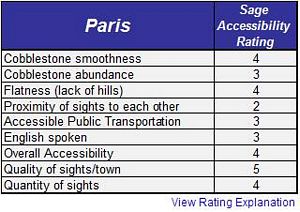 By John Sage
By John Sage
Paris Disabled Access – Many disabled travelers think Paris is not wheelchair friendly, but that isn’t totally true. Nearly all of Paris’ accessibility challenges can be overcome if you know how to get around the various barriers. Do your homework beforehand (with our help), and your wheelchair accessible travel to Paris will be a great trip!
Paris Disabled Access – Best Aspects
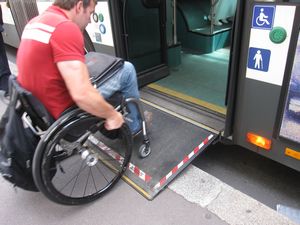 Wheelchair ramps on public buses – Nearly all of the Paris buses feature wheelchair ramps. Although sometimes the wheelchair ramp isn’t always operational, since the buses run frequently one with an operational ramp is never far away (photo of John Sage using an accessible bus is shown on the right).
Wheelchair ramps on public buses – Nearly all of the Paris buses feature wheelchair ramps. Although sometimes the wheelchair ramp isn’t always operational, since the buses run frequently one with an operational ramp is never far away (photo of John Sage using an accessible bus is shown on the right).
Few hills – Manual wheelchair users will enjoy that Paris is fairly flat. The biggest exceptions are the area around the Sacre Cœur Basilica and near the Panthéon. In these areas, manual wheelchair users and other disabled visitors may encounter difficulties.
Smooth sidewalks – Most sidewalks in Paris are smooth and without cobblestones (image at the below left shows a smooth sidewalk and image at the below right shows a typical Paris curb cut). This is particularly true in the Right Bank near the Louvre as well as on the Champs-Elysées. The largest concentration of cobblestones is found in the Left Bank near the Panthéon and the Latin Quarter.
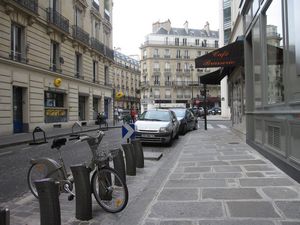
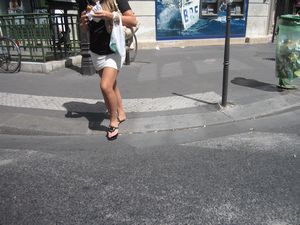
Accessibility at the major tourist attractions – The most popular attractions (the Musée du Louvre, the Eiffel Tower, and the Notre Dame Cathedral) are generally wheelchair accessible. Accessible entrance to the Louvre is possible by taking the elevator located at the Pyramid down to the ticket booth. The north leg of the Eiffel Tower has an elevator that wheelchair tourists can use (shown in the image below on the left). Notre Dame has a small half-step at the exit that provides the most accessible entrance for wheelchair users (shown in the image below on the right).
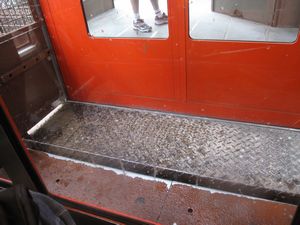
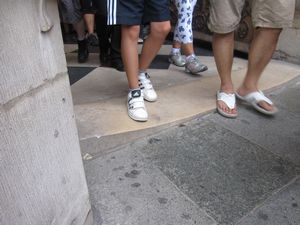
Accessible boat tours and bus tours are available – Although most pathways down to the Seine river involve steps, there are ramps near some of the boat docks that wheelchair users can utilize. Some of the bus tours have buses with wheelchair accessible ramps for disabled tourists, too.
Paris Disabled Access – Most Challenging Aspects
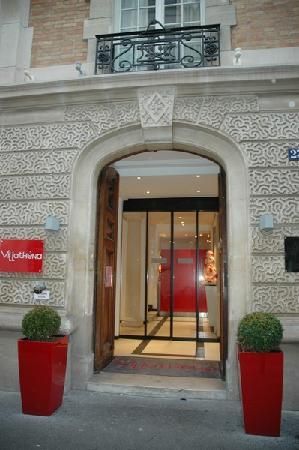 Accessibility features in 19th century buildings – Parisians take pride in the appearance of their city and have preserved their 19th century buildings in both the Left Bank and Right Bank. The historical buildings in Paris, including many of the hotels and restaurants, often have a step or two at the entrance (shown in the image on the right). Another example of an accessibility challenge is an inaccessible ATM machine (shown in the image below).
Accessibility features in 19th century buildings – Parisians take pride in the appearance of their city and have preserved their 19th century buildings in both the Left Bank and Right Bank. The historical buildings in Paris, including many of the hotels and restaurants, often have a step or two at the entrance (shown in the image on the right). Another example of an accessibility challenge is an inaccessible ATM machine (shown in the image below).
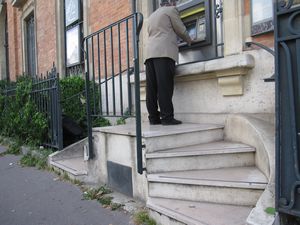
Paris Metro disabled access – There are only a few accessible metro (subway) stations in Paris. The ones that are accessible are not very helpful for getting between the tourist sights. Disabled tourists should use the accessible bus system instead.
Tourist attractions are spread out – Many of the tourist attractions in Paris are not within walking distance of each other. At least 3 km separates Sacre Cœur in the north, Notre Dame in the east, and the Eiffel Tower in the West.
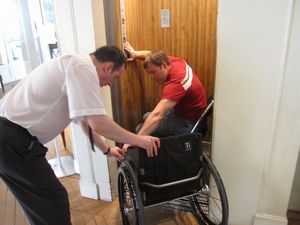 Disabled access at Paris tourist attractions – Accessibility at Paris tourist attractions falls short when compared to other cities in Europe. Several of the museums and churches have not been fully modified to meet basic accessibility standards. An example is the Marmottan Monet Museum (shown in the image on the right) where wheelchair users need to transfer to a portable chair because the elevator is too small for wheelchairs. Tourist attractions that are not wheelchair accessible or require using an alternative accessible entrance include Sacre Cœur Basilica, Sainte-Chapelle church, the Arc de Triomphe, the Panthéon (shown below on the left), the Carnavalet Museum, and the Cluny Museum. Parts of the Louvre, such as the area around the Winged Victory statue (shown in the image below on the right) have steps to reach them.
Disabled access at Paris tourist attractions – Accessibility at Paris tourist attractions falls short when compared to other cities in Europe. Several of the museums and churches have not been fully modified to meet basic accessibility standards. An example is the Marmottan Monet Museum (shown in the image on the right) where wheelchair users need to transfer to a portable chair because the elevator is too small for wheelchairs. Tourist attractions that are not wheelchair accessible or require using an alternative accessible entrance include Sacre Cœur Basilica, Sainte-Chapelle church, the Arc de Triomphe, the Panthéon (shown below on the left), the Carnavalet Museum, and the Cluny Museum. Parts of the Louvre, such as the area around the Winged Victory statue (shown in the image below on the right) have steps to reach them.
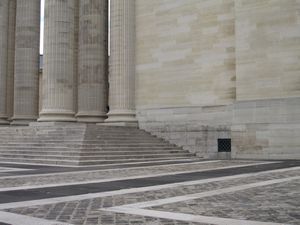
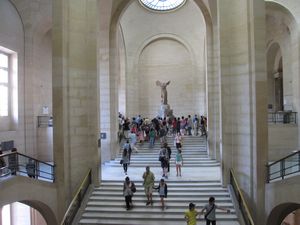
Few truly accessible hotels – Many Paris hotels that call themselves accessible do not actually provide the minimum accessibility features that disabled travelers might expect. There are not many accessible hotels in central Paris that have a step-free entrance, a bathroom door wide enough for wheelchair users, grab bars near the toilet, and a roll-in shower.
Mobility scooters on Paris buses – While most of the time mobility scooter users have no problems using the buses, sometimes a driver will tell you that they are not allowed. Speaking French can help, but if you’re not a Francophone you should have a back-up plan to call a wheelchair accessible taxi to get to your destination.
Want a 100% Accessible Vacation?
View our Paris Accessible Travel Packages
Read more:
Paris Accessible Travel – main page
Pros and Cons of Paris Disabled Access
13 Wheelchair Accessible Travel Tips for Paris France
11 Keys to Success for Paris Disabled Travel
Paris Accessible Travel Packages
Accessible Walking and Driving Tours in Paris
Accessible Paris Boat Tour on the Seine River
Highlights of Paris Accessible Driving Tour
Classic Paris Accessible Walking Tour
Wheelchair Accessible Tour of Paris Latin Quarter
Wheelchair Accessible Guided Tour of the Louvre Museum
Giverny & Versailles Wheelchair Accessible Tour
Accessible Hotels in Paris
Paris Accessibility Guide by John Sage
Paris Trip Planning by Sage Traveling – Travel with Ease!
Contact our Paris accessible travel consultants


